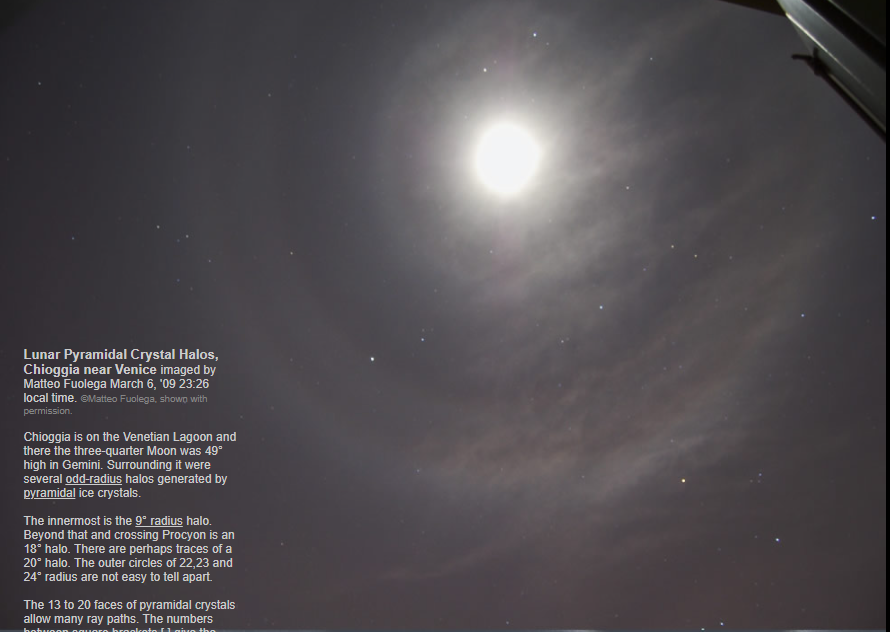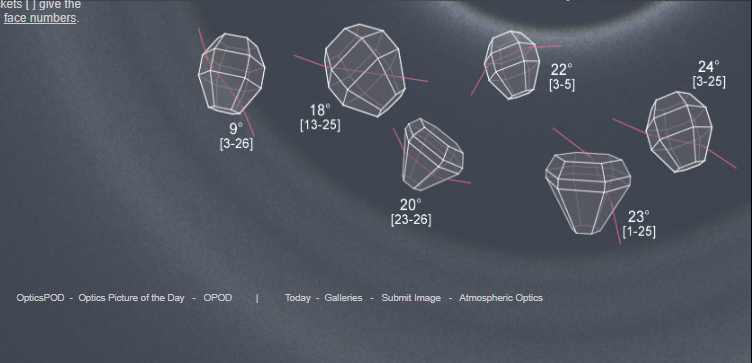Lunar Pyramidal display nr Venice
Lunar Pyramidal Display near Venice: A Mesmerizing Atmospheric Phenomenon
Have you ever witnessed a lunar pyramidal display? If not, let us take you on a journey to Chioggia, a picturesque town near Venice, where such a captivating spectacle unfolded in the night sky. On March 6, 2009, at 23:26 local time, Matteo Fuolega captured a stunning image of Lunar Pyramidal Crystal Halos. These peculiar halos were formed by pyramidal ice crystals and created an ethereal ambiance around the three-quarter Moon, which was positioned 49° high in the constellation of Gemini.
The Enigmatic Halos and Their Radii
The lunar pyramidal display near Venice showcased an array of halos with odd radii, adding to the mystique of the phenomenon. Let's explore these halos in more detail:
- 9° Radius Halo: This halo, the innermost of the display, encircled the Moon and contributed to its otherworldly glow.
- 18° Halo: Extending beyond the 9° radius halo and crossing Procyon, this halo added an additional layer of enchantment to the celestial scene.
- 20° Halo: Although faint, there were hints of a 20° halo in the lunar pyramidal display, further enhancing its complexity.
- 22°, 23°, and 24° Radii: These outer circles were challenging to distinguish from one another due to their close proximity.
The Intricate Nature of Pyramidal Ice Crystals
What causes such a mesmerizing display in the sky? The answer lies in the unique properties of pyramidal ice crystals. These crystals possess anywhere from 13 to 20 faces, allowing for a multitude of ray paths within their structure. As light passes through these crystals, it undergoes various interactions, resulting in the formation of the captivating halos observed in the lunar pyramidal display near Venice.
Exploring Ray Paths within Pyramidal Ice Crystals
To gain a deeper understanding of how pyramidal ice crystals contribute to the formation of halos, let's delve into the intricate world of ray paths. The entrance and exit ray face numbers provide valuable insights into the complex journey of light within these crystals. While the specific ray path details may vary, the multitude of possibilities offered by the numerous crystal faces creates a kaleidoscope of refracted and reflected light, ultimately manifesting as the ethereal halos witnessed in the night sky.
Captivating Visuals: A Glimpse into the Lunar Pyramidal Display
As Matteo Fuolega's image captures the lunar pyramidal display near Venice, it allows us to marvel at the breathtaking beauty of this atmospheric phenomenon. The ethereal halos, gracefully encircling the Moon, create a sense of wonder and awe. The interplay of light and ice crystals transforms the night sky into a canvas of celestial artistry, leaving observers captivated by its enchanting allure.
Unveiling the Secrets of Atmospheric Optics
The lunar pyramidal display near Venice serves as a reminder of the countless wonders that atmospheric optics has to offer. By exploring the intricacies of light interaction with ice crystals, we gain a deeper understanding of the mesmerizing phenomena that grace our skies. From halos and rainbows to iridescence and mirages, these optical phenomena continue to fascinate and inspire scientists, photographers, and sky gazers alike.
Conclusion: A Night to Remember
The lunar pyramidal display near Venice was a rare and captivating spectacle that left observers in awe. The odd-radius halos generated by pyramidal ice crystals added an element of mystery and enchantment to the night sky. As we delve into the intricate nature of pyramidal ice crystals and their role in creating these ethereal halos, we gain a greater appreciation for the beauty and complexity of atmospheric optics. May this mesmerizing phenomenon continue to inspire and ignite our curiosity about the wonders that unfold above us.

Lunar Pyramidal Crystal Halos, Chioggia near Venice imaged by Matteo Fuolega March 6, '09 23:26 local time. ©Matteo Fuolega, shown with permission.
Chioggia is on the Venetian Lagoon and there the three-quarter Moon was 49° high in Gemini. Surrounding it were several odd-radius halos generated by pyramidal ice crystals.
The innermost is the 9° radius halo. Beyond that and crossing Procyon is an 18° halo. There are perhaps traces of a 20° halo. The outer circles of 22,23 and 24° radius are not easy to tell apart.
The 13 to 20 faces of pyramidal crystals allow many ray paths. The numbers between square brackets . . give the entrance and exit ray face numbers.

Note: this article has been automatically converted from the old site and may not appear as intended. You can find the original article here.
Reference Atmospheric Optics
If you use any of the definitions, information, or data presented on Atmospheric Optics, please copy the link or reference below to properly credit us as the reference source. Thank you!
-
<a href="https://atoptics.co.uk/blog/lunar-pyramidal-display-nr-venice/">Lunar Pyramidal display nr Venice</a>
-
"Lunar Pyramidal display nr Venice". Atmospheric Optics. Accessed on November 5, 2024. https://atoptics.co.uk/blog/lunar-pyramidal-display-nr-venice/.
-
"Lunar Pyramidal display nr Venice". Atmospheric Optics, https://atoptics.co.uk/blog/lunar-pyramidal-display-nr-venice/. Accessed 5 November, 2024
-
Lunar Pyramidal display nr Venice. Atmospheric Optics. Retrieved from https://atoptics.co.uk/blog/lunar-pyramidal-display-nr-venice/.